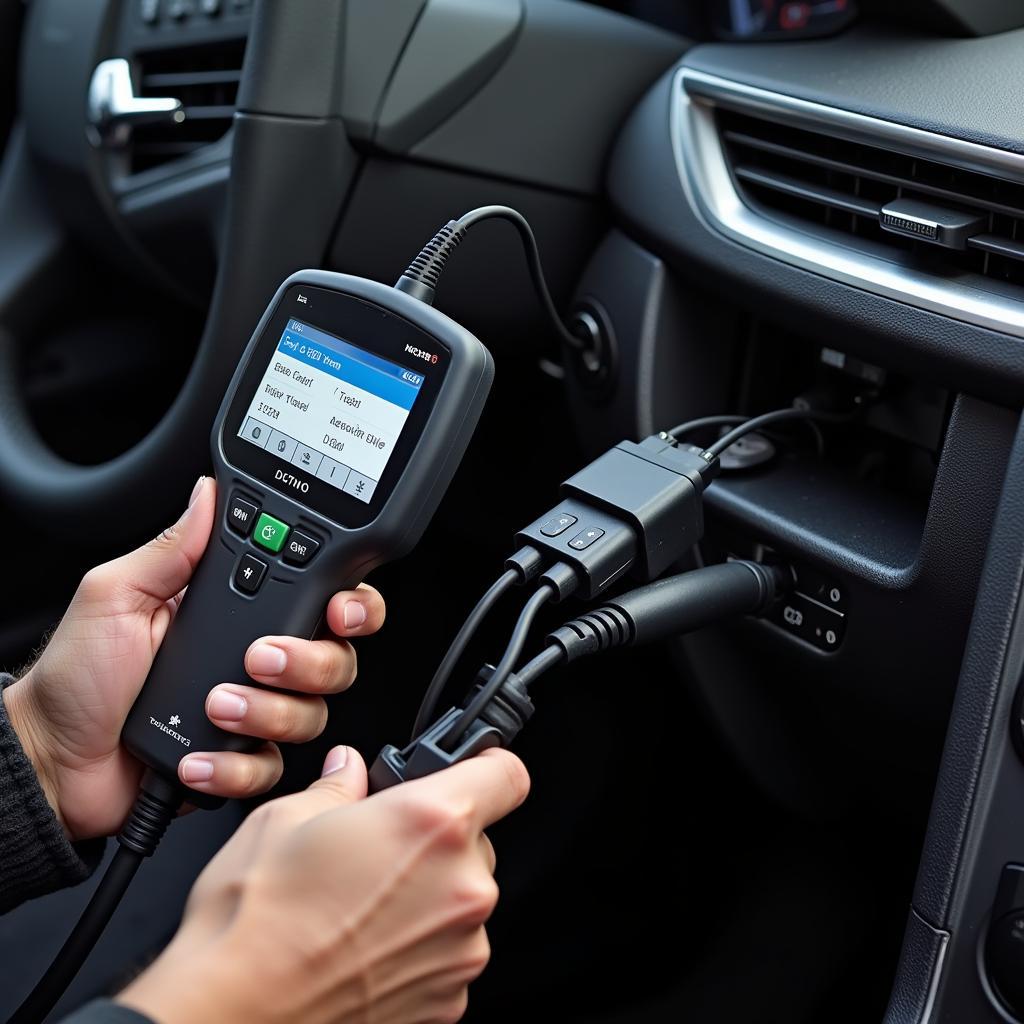The Chevy Volt, a pioneer in hybrid technology, is known for its fuel efficiency and innovative design. Like any vehicle, it relies on a complex network of sensors and computers to ensure optimal performance. The On-Board Diagnostics II (OBD2) system plays a crucial role in monitoring this network, alerting you to potential issues through Diagnostic Trouble Codes (DTCs). Understanding how to perform a Chevy Volt OBD2 reset can be a valuable tool for owners.
Understanding Your Chevy Volt’s OBD2 System
The OBD2 system in your Chevy Volt is constantly monitoring your car’s engine, transmission, emissions system, and various other components. When it detects a problem, it generates a specific DTC that is stored in the vehicle’s computer. These codes can range from minor issues, like a loose gas cap, to more serious problems requiring professional attention.
When You Might Need a Chevy Volt OBD2 Reset
There are a few common scenarios when you might need to perform an OBD2 reset on your Chevy Volt:
- After resolving a problem: Once you’ve addressed the underlying issue that triggered the Check Engine Light, you’ll need to reset the OBD2 system to clear the code and turn off the light.
- Following routine maintenance: Some maintenance procedures, like battery disconnections or replacements, might trigger DTCs. A reset is necessary to clear these codes.
- To clear intermittent issues: If your Check Engine Light comes on sporadically, and you’ve ruled out any serious problems, a reset can help clear temporary glitches.
Important Note: While a Chevy Volt OBD2 reset can be a helpful tool, it’s essential to remember that it doesn’t magically fix the underlying problem. If your Check Engine Light persists after a reset, it’s crucial to have your vehicle diagnosed by a qualified mechanic.
Methods for Performing a Chevy Volt OBD2 Reset
You have a couple of options when it comes to resetting your Chevy Volt’s OBD2 system:
1. Using an OBD2 Scanner
An OBD2 scanner is a handheld device that plugs into your car’s OBD2 port, typically located under the dashboard on the driver’s side. These scanners offer varying levels of functionality, from basic code reading and clearing to more advanced features like live data streaming and component testing.
Steps for using an OBD2 scanner:
- Locate the OBD2 port and plug in the scanner.
- Turn on the ignition to the “on” position (don’t start the engine).
- Follow the scanner’s prompts to access the DTCs.
- Select the “Clear Codes” or “Reset” option.
Pro Tip: Investing in a quality obd2 scanner for chevy volt can save you money in the long run by allowing you to diagnose and clear minor issues yourself.
2. Battery Disconnect Method
This method involves disconnecting the battery to reset the car’s computer, effectively clearing the OBD2 codes.
Steps for the battery disconnect method:
- Locate the negative terminal on your car battery.
- Disconnect the negative battery cable using a wrench.
- Wait for at least 15 minutes to allow the computer to reset.
- Reconnect the negative battery cable and tighten it securely.
Caution: Disconnecting the battery can erase saved settings in your car, such as radio presets and clock settings.
Common Chevy Volt OBD2 Codes
Here are a few examples of DTCs you might encounter with your Chevy Volt:
- P0420: Catalyst System Efficiency Below Threshold (Bank 1)
- P0171: System Too Lean (Bank 1)
- P0101: Mass Air Flow (MAF) Sensor Performance
- P0300: Random/Multiple Cylinder Misfire Detected
Remember: These are just a few examples, and the specific codes you encounter will depend on the nature of the issue with your vehicle. Always refer to a reliable OBD2 code database or consult a mechanic for accurate code interpretations.
Expert Insights
“Understanding your car’s OBD2 system can empower you as a vehicle owner,” says automotive expert John Smith, a certified mechanic with over 20 years of experience. “While a Chevy Volt OBD2 reset can be a useful tool for minor issues, it’s essential to remember that it’s not a permanent fix. If the problem persists, seeking professional diagnosis and repair is crucial to prevent potential damage to your vehicle.”
Conclusion
Performing a Chevy Volt OBD2 reset can be a straightforward process when armed with the right information and tools. Whether you opt for an OBD2 scanner or the battery disconnect method, remember to prioritize safety and follow the steps carefully. While a reset can temporarily clear trouble codes, addressing the underlying issue is crucial for ensuring your Chevy Volt runs smoothly and efficiently for years to come.
FAQs
1. How often should I reset my Chevy Volt’s OBD2 system?
It’s not recommended to reset your OBD2 system regularly unless you’ve addressed a specific issue triggering the Check Engine Light.
2. Can I drive my Chevy Volt with the Check Engine Light on?
While driving short distances with the Check Engine Light on might be possible, it’s best to have the issue diagnosed promptly to prevent potential damage and ensure safe driving.
3. Will resetting the OBD2 system void my warranty?
No, resetting your OBD2 system will not void your warranty. However, tampering with emissions components or modifying the vehicle’s software could potentially affect warranty coverage.
4. Why is my Check Engine Light still on after a reset?
If your Check Engine Light remains illuminated after a reset, it indicates the underlying issue hasn’t been resolved. It’s crucial to have your vehicle diagnosed to identify and fix the problem.
5. Can I use any OBD2 scanner for my Chevy Volt?
While most standard OBD2 scanners can read and clear basic codes, investing in a scanner specifically designed for hybrid vehicles like the Chevy Volt might provide more comprehensive diagnostics and functionality.
Need Further Assistance? Our team of automotive experts is here to help! Contact us via WhatsApp at +1(641)206-8880 or email [email protected]. We offer 24/7 customer support to answer all your OBD2 and vehicle diagnostic questions.


